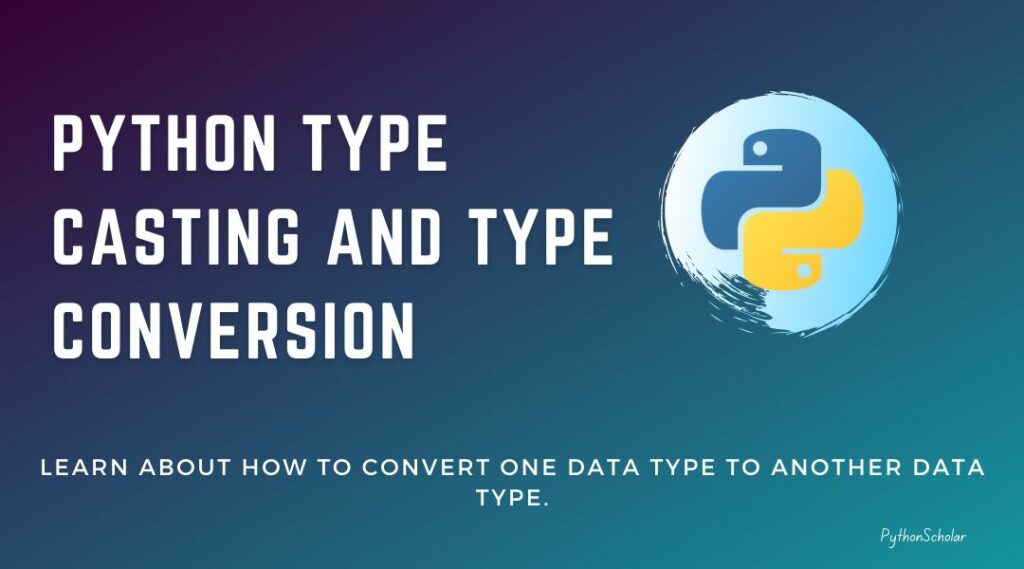In this tutorial, we will learn about Python Type Casting by using python type conversion.
To understand python typecasting, we need a basic understanding of data types.

What is Python Type Casting and Type Conversion?
Python Casting or typecasting is the way to change the data type of a variable, which can help day-to-day competitive programming. Type casting in Python refers to the conversion of one data type to another. It is a useful technique for manipulating and formatting data, especially in data analysis and scientific computing.
In python, there are two types of Type conversion:
- Implicit Type Conversion
- Explicit Type Conversion
Let us understand python typecast one by one.
Implicit Type Conversion
When the python interpreter automatically changes the data type without programmer intervention, it is called Implicit type conversion. Object’s data type.
Let see a simple example of implicit type conversion in python.
Example:
X = 2
print("The type of X variable is :" , type(X))
Y = 3.5
print("The type of Y variable is :" , type(Y))
X = X + Y
print(X)
print("After addition the type of X variable is : ", type(X))
When we execute the above program, we will get the following result.
Output:
The type of X variable is : <class 'int'> The type of Y variable is : <class 'float'> 5.5 After addition the type of X variable is : <class 'float'>
Here we are taking the X variable as Integer and the Y variable as a float. Then we are adding Y’s value, which is a float with Value of X, which is Integer when after the addition, we are getting output as 5.5 in a float. We can also see that after the addition, the data type of X is also changed to float from an integer automatically by the python interpreter; this is how Implicit type conversion works.
This type of conversion is also called UpCasting.
Explicit Type Conversion
Unlike Implicit type conversion, in explicit type conversion, we have to manually convert the data type of an object Object’s data type.
We can use the following predefined functions to perform explicit type conversion.
- int()
- float()
- str()
- bool()
- complex()
- list()
- set()
- tuple()
- dict()
- chr()
- ord()
- hex()
- oct()
Python int()
The int() function converts the base of any number or a string to an integer.
Let us check an example of the int() function.
Example:
X = int(2)
print("The type of X variable is: ", type(X))
Y = 3.4
Y = int(Y)
print(Y)
print("The type of Y variable is: ", type(Y))
Z = "54"
Z = int(Z)
print("The type of Z variable is: ", type(Z))
print(int(True))
print(int(False))
The output will be as follows.
The type of X variable is: <class 'int'> 3 The type of Y variable is: <class 'int'> The type of Z variable is: <class 'int'> 1 0
In the above program,
We are declaring variable X using the int() function. Then we are declaring variable Y with a float. Then we convert it using the int() method from float to integer.
We are declaring variable Z with string, and then we are converting it to an integer.
We convert the Boolean value to an integer which refers to True as 1 and false as 0.
Note:
- We can only convert string if an only string has a base with 0-9. We cannot convert a string like A-Z to the integer using int()
- We cannot convert complex datatypes to an integer.
Python float()
This function is used to convert any data types of a float number.
For Example
X = float(2.1)
print("The type of X variable is: ", type(X))
X1 = float(1)
print(X1)
Y = 31
Y = float(Y)
print(Y)
print("The type of Y variable is: ", type(Y))
Z = "3.7"
Z = float(Z)
print("The type of Z variable is: ", type(Z))
print(float(True))
print(float(False))
When we run the above code, we will get the following output:
The type of X variable is: <class 'float'> 1.0 31.0 The type of Y variable is: <class 'float'> The type of Z variable is: <class 'float'> 1.0 0.0
Note:
- We can only convert string if the only string has a base with 0-9. We cannot convert a string like A-Z to the integer using float()
- We cannot convert complex data types to float.
Python str()
This function is used to convert data types like integer or float into a string.
X = str(1)
Y = str(3.7)
Z = str(10+5j)
bool1 = str(True)
bool2 = str(False)
print("The type of variable X is :", type(X))
print("The type of variable Y is :", type(Y))
print("The type of variable Z is :", type(Z))
print("The type of variable bool1 is :", type(bool1))
print("The type of variable bool2 is :", type(bool2))
The output will be as follows.
The type of variable X is : <class 'str'> The type of variable Y is : <class 'str'> The type of variable Z is : <class 'str'> The type of variable bool1 is : <class 'str'> The type of variable bool2 is : <class 'str'>
Python bool()
This function is used to convert any data type to a boolean data type easily.
Example:
X = bool(0)
Y = bool(1)
Z = bool(3.7)
A = bool("Python")
B = bool("")
C = bool(-23)
print(X)
print(Y)
print(Z)
print(A)
print(B)
print(C)
Output:
False True True True False True
With the help of the bool function, we can convert any type of data type into a boolean. The output will be – For all values, it will produce True except for an empty String.
Python complex()
This function is used to convert natural numbers to complex numbers. However, If we want to convert X and Y into complex numbers, X will be the real part, and Y will be the imaginary part.
Example:
X = 2
Y = 5
Z = complex(X,Y)
print(Z)
print("The Type of Z variable is:", type(Z))
A = True
B = False
C = complex(A,B)
print(C)
print("The Type of C variable is:", type(C))
The output will be as follows.
(2+5j) The Type of Z variable is: <class 'complex'> (1+0j) The Type of C variable is: <class 'complex'>
Python list()
This function is used to convert any data type into a list type.
Example:
my_tuple = (1,2,4,5)
my_set = {'P','Y','T','H','O','N'}
my_string = "HelloWorld"
my_tuple = list(my_tuple)
print(my_tuple)
print("The type of my_tuple is:", type(my_tuple))
my_set = list(my_set)
print(my_set)
print("The type of my_set is:", type(my_set))
my_string = list(my_string)
print(my_string)
print("The type of my_string is:", type(my_string))
Output:
[1, 2, 4, 5] The type of my_tuple is: <class 'list'> ['H', 'T', 'Y', 'N', 'P', 'O'] The type of my_set is: <class 'list'> ['H', 'e', 'l', 'l', 'o', 'W', 'o', 'r', 'l', 'd'] The type of my_string is: <class 'list'>
Python set()
This function is used to convert any datatypes to a set.
Example:
my_tuple = (1,2,4,5)
my_list = ['P','Y','T','H','O','N']
my_string ="HelloWorld"
my_tuple = set(my_tuple)
print(my_tuple)
print("The type of my_tuple is:", type(my_tuple))
my_list = set(my_list)
print(my_list)
print("The type of my_list is:", type(my_list))
my_string = set(my_string)
print(my_string)
print("The type of my_string is:", type(my_string))
The output will be as follows.
{1, 2, 4, 5}
The type of my_tuple is: <class 'set'>
{'Y', 'N', 'O', 'H', 'T', 'P'}
The type of my_list is: <class 'set'>
{'d', 'H', 'W', 'o', 'e', 'r', 'l'}
The type of my_string is: <class 'set'>
Python tuple()
This function is used to convert data types to a tuple.
Example:
my_list = [1,2,4,5]
my_set = {'P','Y','T','H','O','N'}
my_string = "HelloWorld"
my_list = tuple(my_list)
print(my_list)
print("The type of my_list is:", type(my_list))
my_set = tuple(my_set)
print(my_set)
print("The type of my_set is:", type(my_set))
my_string = tuple(my_string)
print(my_string)
print("The type of my_string is:", type(my_string))
The output will be as follows.
(1, 2, 4, 5)
The type of my_list is: <class 'tuple'>
('H', 'Y', 'T', 'O', 'P', 'N')
The type of my_set is: <class 'tuple'>
('H', 'e', 'l', 'l', 'o', 'W', 'o', 'r', 'l', 'd')
The type of my_string is: <class 'tuple'>
Python dict()
This function is used to convert a tuple with key and value of order into a dictionary.
Example:
my_tup = (('a',1),('b',2),('c',3))
print(my_tup)
my_tup = dict(my_tup)
print(my_tup)
print("The type of my_tup is :", type(my_tup))
The output will be as follows.
(('a', 1), ('b', 2), ('c', 3))
{'a': 1, 'b': 2, 'c': 3}
The type of my_tup is : <class 'dict'>
Python chr()
This function is used to convert numbers to their corresponding ASCII character.
X = 65 Y = 97 Z = 33 print(chr(X)) print(chr(Y)) print(chr(Z))
The output will be as follows.
A a !
Python ord()
This function is used to convert a character to an integer.
X = 'P' print(ord(X))
Output:
80
Python hex()
This function is used to convert integers to hexadecimal strings.
Example:
X = 80 print(hex(X))
Output:
0x50
Python oct()
This function is used to convert integers to octal strings.
Example:
X = 80 print(oct(X))
Output:
0o120
Conclusion
In conclusion, Python’s type casting and type conversion features allow programmers to easily convert data between different types. This flexibility is crucial for efficient data manipulation and analysis, making Python a popular language for scientific computing, data analysis, and more.
FAQ
What is type casting in Python?
Type casting is the act of transforming a particular data type to another data type in Python.
What is type conversion in Python?
Type conversion is an alternate expression for type casting in Python, and it denotes the action of modifying one data type to another.
Why is type casting important in Python?
Type casting is important in Python because it allows programmers to manipulate and format data efficiently. It is especially useful in data analysis, scientific computing, and other fields that require extensive data manipulation.
How is type casting done in Python?
To carry out type casting in Python, the language provides built-in functions such as int(), str(), float() and others, which enable the conversion of data from one data type to another.
What are some common use cases for type casting in Python?
Some common use cases for type casting in Python include converting strings to numbers for mathematical calculations, converting numbers to strings for formatting and output, and converting between different data structures such as lists and tuples.
What is type casting in Python, and why is it important?
Type casting is the process of converting one data type to another in Python. It is essential for efficient data manipulation in scientific computing, data analysis, and other fields. By using built-in functions such as int(), str(), and float(), programmers can easily convert data between types.
How does type casting work in Python?
Type casting in Python involves using built-in functions to convert data from one type to another. For example, the int() function can convert a string to an integer, while the str() function can convert a number to a string. This flexibility allows programmers to manipulate and format data efficiently for a wide range of use cases.
What are some common use cases for type casting in Python?
Type casting is useful in a variety of situations, including converting strings to numbers for mathematical calculations, converting numbers to strings for formatting and output, and converting between different data structures such as lists and tuples. Its versatility makes it a popular feature for scientific computing, data analysis, and other fields.
How can I learn more about type casting and type conversion in Python?
There are many online resources available for learning about type casting and type conversion in Python, including tutorials, documentation, and online courses. Python Scholar is a valuable online resource for learning Python programming and exploring its many features, including type casting and type conversion.
